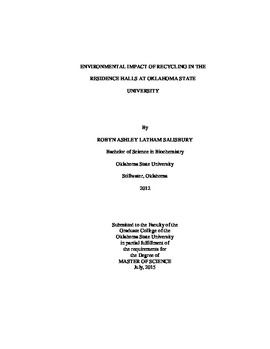| dc.description.abstract | Colleges and universities have the ability and the responsibility to provide their students with access to sustainability education and programs (Orr, 1994; Emanuel & Adams, 2011; Pursehouse, 2012; Owens & Halfacre-Hitchcock, 2003). Housing departments have an additional responsibility to provide access to sustainability and recycling programs because of their almost unlimited access to students living on-campus (Pursehouse, 2012). The purpose of this study was to gain a better understanding of recycling at Oklahoma State University-Stillwater by conducting an evaluation of the on-campus recycling program. The evaluation was done by conducting a cost-benefit analysis and by surveying undergraduate students living on-campus on their attitudes, knowledge, and behavior when it comes to recycling. A nine-step cost-benefit analysis was conducted on the move-in recycling program that took place for the first time in August 2013. The cost-benefit analysis was conducted to determine whether or not it was economically feasible for the move-in recycling program to continue. The recycling survey consisted of four questionnaires, one each for attitudes, knowledge, behavior, and demographics. The survey population was undergraduate students living in Single Student Housing at OSU-Stillwater. Students were selected randomly to participate in the study with a response rate of 6.9%. For the global perspective, the cost-benefit analysis resulted in a NPV=-$3,119 and a B/C=0.45, and for the Residential Life perspective a NPV=$1,553 and a B/C=20.41 resulted. The recycling survey indicated an overall favorable attitude towards recycling. Additionally, students scored an average score of M=5.2 out of 10 on the recycling knowledge questionnaire. Finally, 43.7% (N=97) students indicated that they never, very rarely, or rarely recycle, while 34.8% (N=72) indicated that they always, very frequently, or frequently recycle. Based on the results of the cost-benefit analysis, it is recommended that recycling continue to occur as a part of move-in waste collection. Additionally, it is recommended that more education on recycling be provided to the residents. This education should include information on what to recycle as well as the location of recycling bins. If these recommendations are followed it is likely that improvements to OSU�s recycling program and improved participation in the program will be seen. | |
